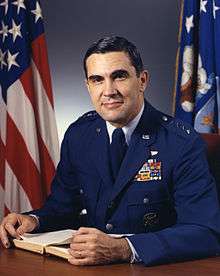Richard L. Lawson
| Richard L. Lawson | |
|---|---|
 Official portrait | |
| Born |
December 29, 1929 Fairfield, Iowa |
| Allegiance | United States |
| Service/branch | United States Air Force |
| Years of service | 1951–1986 |
| Rank |
|
| Commands held |
Deputy Commander for Operations 306th Bombardment Wing 28th Bombardment Wing 8th Air Force Chief of Staff Supreme Headquarters Allied Powers Europe Deputy Commander in Chief United States European Command[1] |
| Battles/wars |
Cold War Korean War Vietnam War |
Richard Laverne Lawson (born December 19, 1929)[2] is a former General and former deputy commander in chief, Headquarters United States European Command, Stuttgart-Vaihingen, Germany.
Biography
Early life
Lawson was born in Fairfield, Iowa, in 1929, where he graduated from high school. He attended the University of Iowa at some point after high school.[1]
While at Parsons College, Lawson enlisted in the Iowa Army National Guard and was later called to active duty as the 133rd Infantry Regiment's sergeant major at Fort Riley, Kansas. He was commissioned a second lieutenant in November 1951 and assigned as adjutant for the 133rd Aircraft Control and Warning Squadron, Alexandria, Louisiana. He graduated from Parsons in 1951 with a bachelor of science degree.[1]
In May 1952 Lawson entered pilot training at Columbus Air Force Base, Mississippi, and completed training at Reese Air Force Base, Texas in July 1953. He was then assigned to the 69th Bombardment Squadron at Loring Air Force Base, Maine, as a B-36 Peacemaker co-pilot and aide-decamp to Brigadier General Bertram C. Harrison. He accompanied General Harrison to the 72nd Bombardment Wing, Ramey Air Force Base, Puerto Rico, in July 1955. While there he continued to serve as aide to General Harrison and also Brigadier General H.R. Sullivan. However, his primary duty was as chief, Operations Control Division, 72nd Bombardment Wing. Lawson returned to the United States in June 1958 and was assigned to staff officer positions in the 5th Bombardment Wing, located at Travis Air Force Base, California.[1]
The general transferred to Headquarters Strategic Air Command at Offutt Air Force Base, Nebraska, in September 1961 and served as a member of the European Force Application Team, Joint Strategic Target Planning Staff. In September 1963 he entered the Air Command and Staff College. Upon graduation Lawson returned to Strategic Air Command Headquarters and was assigned as an operations planner in the Concepts Division, Operations Plans Directorate. He graduated from the Air Command and Staff College at Maxwell Air Force Base, Alabama, in 1964 and concurrently earned a master of public administration degree from The George Washington University, Washington D.C. He became chief of the Future Concepts Branch in February 1967 and entered the National War College in July 1968. He completed the National War College at Fort Lesley J. McNair in 1969.[1]
Later career
From June 1969 to February 1970, Lawson served at McCoy Air Force Base, Florida, as deputy commander for operations, 306th Bombardment Wing. He subsequently took command of the 28th Bombardment Wing, then deployed to the Western Pacific from Ellsworth Air Force Base, South Dakota. He returned to Ellsworth with the wing in March 1970.[1]
Lawson was assigned, in July 1971, to Headquarters United States Air Force, Washington D.C., in the Directorate of Operations, Office of the Deputy Chief of Staff, Plans and Operations, with duty as chief, Strategic Division, and, in July 1972, was named deputy director for strategic operational forces. In February 1973 he became deputy director of operations.[1]
Appointed military assistant to the president in August 1973, Lawson served at the White House until March 1975 when he returned to Air Force headquarters as director of plans, and remained there until June 1977. He was then assigned as commander, 8th Air Force at Barksdale Air Force Base, Louisiana. In July 1978 he was named director for plans and policy, J-5, Organization of the Joint Chiefs of Staff, Washington D.C. He received an honorary doctorate of laws degree from Centenary College, Shreveport, Louisiana, in 1980.[1]
He was assigned as the U.S. representative to the Military Committee of the North Atlantic Treaty Organization, Brussels, Belgium in July 1980 and moved to Mons, Belgium, in July 1981 as chief of staff, Supreme Headquarters Allied Powers Europe. He assumed his present duties as deputy commander in chief, Headquarters United States European Command, Stuttgart-Vaihingen, Germany in August 1983. He retired on December 1, 1986.[1] After his retirement, he began to work in the private sector, including positions as the president and CEO of the National Mining Association.[3]
Awards
Awards earned during his career:[1] Defense Distinguished Service Medal
- Air Force Distinguished Service Medal with an oak leaf cluster
- Legion of Merit with an oak leaf cluster
- Soldier's Medal
- Bronze Star Medal
- Air Medal with an oak leaf cluster
- Joint Service Commendation Medal
- Air Force Commendation Medal with three oak leaf clusters
- Army Commendation Medal
- Presidential Unit Citation emblem with an oak leaf cluster
- Air Force Outstanding Unit Award ribbon with two oak leaf clusters
- Command pilot with more than 7,000 hours, and during the Vietnam War flew 73 combat missions
References
![]() This article incorporates public domain material from the Air Force Historical Research Agency website http://www.afhra.af.mil/.
This article incorporates public domain material from the Air Force Historical Research Agency website http://www.afhra.af.mil/.
- 1 2 3 4 5 6 7 8 9 10 "GENERAL RICHARD L. LAWSON". United States Air Force. Archived from the original on 2012-12-12. Retrieved 28 December 2010.
- ↑ Marquis Who's Who on the Web
- ↑ "Gen Richard L. Lawson, USAF (Ret.)". Commission to Assess the Threat to the United States From Electromagnetic Pulse (EMP) Attack. Retrieved 28 December 2010.